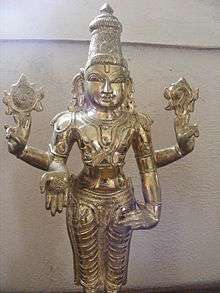Panchaloha
Panchaloha (Sanskrit: पञ्चलोह;), also called Pañcadhātu (Sanskrit: पञ्चधातु, lit. five metals) is a term for traditional five-metal alloys of sacred significance, used for making Hindu temple murti and jewelry.[1]

Composition
The composition is laid down in the Shilpa shastras, a collection of ancient texts that describe arts, crafts, and their design rules, principles and standards. Panchaloha is traditionally described as an alloy of gold(Au), silver(Ag), copper(Cu), zinc(Zn) and iron(Fe) as the major constituents. Also, in some cases tin (Sn) or lead (Pb) is used instead of zinc. It is widely believed that wearing jewellery made of such an alloy brings balance in life, self-confidence, good health, fortune, prosperity, and peace of mind.[2]
In Tibetan culture, it was considered auspicious to use thokcha (meteoric iron) either as a component of the alloy in general or for a specific object or purpose. The amount used could vary, depending upon the material's availability and suitability, among other considerations. A small, largely symbolic quantity of "sky-iron" might be added, or it might be included as a significant part of the alloy-recipe.[3]
See also
![]()
![]()
References
- "What is Panchaloha idol (murti) – components and percentage used?". www.hindu-blog.com.
- B. Ravi (2003), Investment casting development - Ancient and Modern Approaches, National Conference on Investment Casting Central Mechanical Engineering Research Institute, Durgapur, IIT Bombay
- "John Vincent Bellezza: Thogchags, Ancient Amulets of Tibet". www.asianart.com.
Further reading
- The Lost-Wax Casting of Icons, Utensils, Bells, and Other Items in South India, R.M. Pillai, S.G.K. Pillai, and A.D. Damodaran, October 2002, JOM.